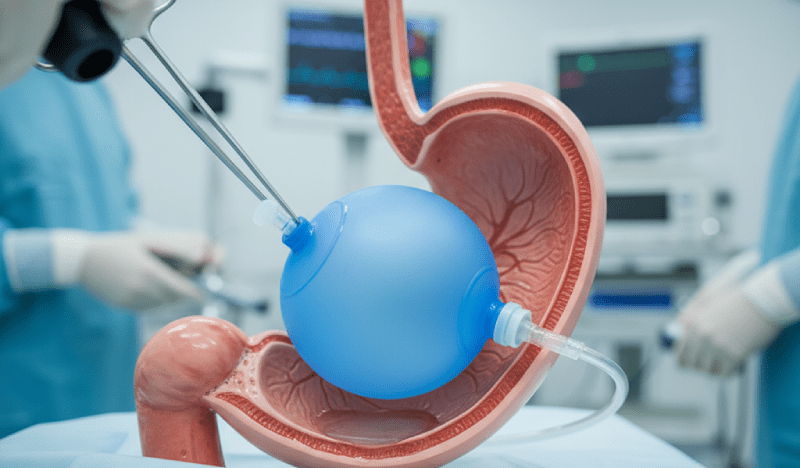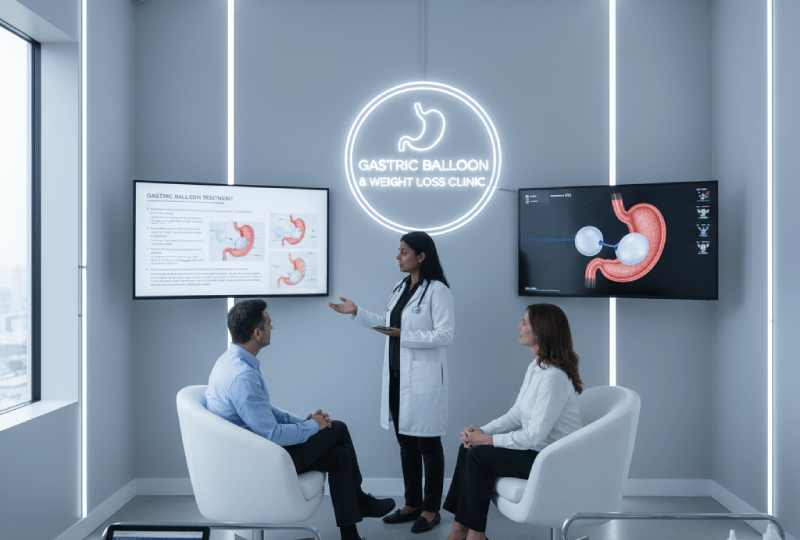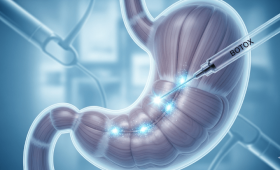Obesity, one of the biggest health problems of our age, is a condition that affects millions of people and seriously reduces the quality of life. Losing weight is not just an aesthetic goal for many, but also the key to living a healthier, more energetic, and longer life. Diet and exercise programs may sometimes not be enough, and in such cases, individuals may turn to more effective solutions. At this point, the gastric balloon procedure stands out as a non-surgical and reliable option.
This guide details what a gastric balloon is, how it works, who it is suitable for, its benefits, potential risks, and all stages of the process. It should be noted that this information is for general guidance only. It is vital to consult a healthcare professional who can evaluate your individual situation before any medical procedure.
What is a Gastric Balloon?
A gastric balloon is a flexible, inflatable device made of a special silicone material. After being placed inside the stomach using an endoscopic method, it is inflated with a sterile liquid (usually saline solution) or air to occupy a large part of the stomach. This feeling of fullness in the stomach helps the person eat less and feel full faster. It typically stays in the stomach for six months to a year, after which it is removed.
How Does a Gastric Balloon Work?
A gastric balloon promotes weight loss through two primary mechanisms. First, it physically occupies space in the stomach, creating a feeling of fullness. This allows people who would normally eat more to feel fuller with smaller portions. Second, it slows down the rate at which the stomach empties. This means the feeling of fullness lasts longer, eliminating the feeling of frequent hunger. These mechanisms help the person to significantly reduce their total calorie intake.
Who Is It Suitable For?
The gastric balloon is an ideal option for individuals with a Body Mass Index (BMI) between 30 and 40. It is an excellent alternative, especially for people who are not suitable for bariatric surgery or do not want to take the risks of an operation. The gastric balloon provides strong support to individuals who are determined to change their eating habits and adopt a healthy lifestyle but are unable to do so on their own.
The Procedure: Step by Step
The gastric balloon placement procedure is quite simple and usually takes about 20-30 minutes. The procedure is performed by a gastroenterologist or a bariatric surgeon in a setting where the patient is under sedation (light sleep). Using a flexible tube called an endoscope, the surgeon guides the deflated balloon through the mouth and esophagus into the stomach. Once the balloon reaches the stomach, it is inflated with a predetermined volume of sterile liquid. After the procedure, the patient is kept under observation for a short time and can usually be discharged on the same day.
Gastric Balloon and Weight Loss Rate and Goals
Weight loss with a gastric balloon varies depending on the person’s initial weight and their adherence to a diet and exercise program. The fastest weight loss is usually experienced within the first few months. On average, individuals can lose 10% to 15% of their total body weight during the time the balloon is in their stomach. However, the real success is maintaining this new weight after the balloon is removed.
Types of Gastric Balloons
There are various types of gastric balloons on the market with different features.
- 6-Month Balloons: This is the most common type. It stays in the stomach for 6 months and is removed endoscopically.
- 12-Month Balloons: Suitable for those seeking a longer-term solution and generally offer greater potential for weight loss.
- Swallowable Balloons (Elipse): A balloon that does not require an endoscopy; it is swallowed in a capsule and self-excretes after approximately 4 months. This allows for a more comfortable post-procedure period.
Advantages of a Gastric Balloon
The gastric balloon offers many significant advantages in the treatment of obesity:
- Non-Surgical: It does not require a surgical incision, stitches, or scars. This is a less invasive method compared to bariatric surgery.
- Reversible: The balloon can be easily removed at any time or at the end of the planned period.
- Low Complication Risk: It carries a lower risk of complications compared to bariatric surgery.
- Motivational Tool: It provides a quick start to the weight loss process, motivating the person and helping them establish healthy habits.
- Short Hospital Stay: There is usually no need for an overnight stay in the hospital after the procedure.
Potential Side Effects and Risks
As with any medical procedure, the gastric balloon also has potential side effects and risks.
- Nausea and Vomiting: These are the most common side effects and usually occur within the first few days. They can be controlled with medication.
- Abdominal Pain: Mild to moderate abdominal cramps and pain may be experienced.
- Reflux: Symptoms of heartburn or reflux may increase.
- Rare Risks: Serious but rare complications such as balloon deflation, leakage, or bowel obstruction may occur.
The Balloon Removal Process
When the period for the balloon to remain in the stomach is over, it is removed endoscopically, similar to the placement procedure. The fluid in the balloon is drained to deflate it, and it is then taken out through the mouth with the help of an endoscope. This procedure is also quite short and is generally painless.

Nutrition After Gastric Balloon
After the gastric balloon is placed, the diet should be changed gradually.
- First 3 Days: Only liquid foods (water, soup, fruit juice) should be consumed.
- Days 4-10: Transition to pureed and soft foods (yogurt, pureed vegetables, baby foods).
- Day 11 and Onward: Gradually return to solid foods in small portions. In this process, the support of a dietitian is very important for acquiring new eating habits.
Exercise with a Gastric Balloon
The gastric balloon procedure alone does not cause weight loss. The success of the process must be reinforced with regular exercise. Light exercises (like walking) can be started in the first few weeks. Later, more intensive sports programs can be started with the doctor’s approval. Exercise not only speeds up your weight loss but also helps maintain muscle mass and boost metabolism.
Psychological Effects of a Gastric Balloon
Weight loss positively affects an individual’s psychological health as much as their physical health. The gastric balloon can be a motivating tool in this process. However, this procedure is not a method of psychological treatment. People with eating disorders or emotional eating habits should seek psychological support during the process to achieve more permanent results.
Gastric Balloon and Weight Loss Sustainability
The most important goal of the gastric balloon is to set the stage for permanent lifestyle changes. The healthy eating and exercise habits acquired during the time the balloon is in the stomach must be continued after it is removed. This is a vital step to prevent regaining the lost weight.
Gastric Balloon and Lifestyle Change
The gastric balloon is not a magic solution. The secret to success lies not in the presence of the balloon, but in the person’s own determination. The balloon is only a starting point and a facilitator on this journey. The person must make an effort to permanently change their eating habits, physical activity, and overall lifestyle.
The Difference Between Gastric Balloon and Bariatric Surgery
The gastric balloon and bariatric surgery (such as sleeve gastrectomy, gastric bypass) are different methods used in the treatment of obesity. The gastric balloon is a non-surgical, temporary, and reversible method, while bariatric surgery is a permanent and invasive surgical procedure. Although the gastric balloon generally results in less weight loss, it is a great alternative for those who prefer not to take the risks of surgery.
Choosing the Right Specialist for a Gastric Balloon
The gastric balloon procedure should be performed by a specialist and experienced doctor. When making a choice, it is important to consider the doctor’s expertise, previous patient experiences, and the post-operative support programs they offer (such as dietitian and psychologist support).
Gastric Balloon and Cost Analysis
The cost of the gastric balloon procedure varies depending on the type of balloon (6-month, 12-month, swallowable), the clinic where the procedure is performed, and the doctor’s fee policy. The cost generally includes the balloon itself, the placement and removal procedures, and a follow-up program.
Gastric Balloon and Insurance Coverage
Generally, the gastric balloon procedure is considered an aesthetic procedure and is not covered by private health insurance. However, in some cases, insurance companies may cover a portion of the costs with a doctor’s report due to serious health problems caused by obesity.
Gastric Balloon and Travel
Traveling with a gastric balloon is generally not a problem. However, to minimize nausea or discomfort, it can be helpful to consume light foods and drink plenty of fluids during long journeys. It is important to consult your doctor before flying.
Gastric Balloon and Pregnancy
The gastric balloon should not be used during pregnancy. If you are planning to become pregnant or find out you are pregnant while a gastric balloon is in place, you should immediately contact your doctor and make a plan for the balloon to be removed as soon as possible.
Gastric Balloon and Alcohol Consumption
Alcohol consumption is not recommended while a gastric balloon is in place. Alcohol can irritate the stomach lining and increase side effects such as heartburn and nausea. Furthermore, alcohol is a high-calorie beverage and can negatively affect your weight loss journey.
Long-Term Outcomes of the Gastric Balloon
The long-term success of the gastric balloon procedure depends on the period after the balloon is removed. Maintaining healthy eating and regular exercise habits during this period ensures that the lost weight is kept off.
Gastric Balloon and Age Limit
The gastric balloon procedure is generally suitable for individuals between the ages of 18 and 65. However, this age range may vary depending on the individual’s overall health and the specialist’s evaluation.
Possible Complications and Solutions
Although rare, some complications may occur after the gastric balloon.
- Severe Nausea and Vomiting: Can be controlled with anti-emetic medications prescribed by the doctor.
- Balloon Deflation: A balloon deflation may be indicated by a change in urine color (blue or green). In this case, a doctor should be consulted immediately.
- Stomach Discomfort: In case of ulcers or irritation, medications recommended by the doctor can be used.
Gastric Balloon and Cure Holiday: Your Reliable Address for Health
The gastric balloon procedure yields the best results when performed by an experienced team in a modern clinical setting. Cure Holiday stands out in this field with its expert doctors and patient-oriented approach. In addition to the gastric balloon procedure, Cure Holiday offers personalized dietitian and psychologist support throughout your treatment process, providing you with complete guidance on your weight loss journey. If you are looking for a reliable and professional partner to achieve your health and ideal weight, you can contact Cure Holiday.
Disclaimer: This article is not a substitute for medical advice. To get more information about the gastric balloon procedure and to determine the most suitable method for you, it is best to consult a specialist. You can contact Cure Holiday to receive a free consultation on this matter.



